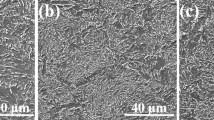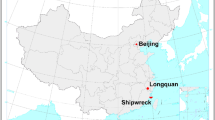Abstract
The corrosion behavior of brass H62 exposed to the atmosphere of Nansha Islands for 21 months was investigated by weight loss, scanning electron microscopy, x-ray diffraction and electrochemical techniques. The results showed that the average corrosion rate of brass H62 exposed for 1 year was approximately 13.47 g m−2 a−1, and the corrosion products were observed to be unevenly distributed, attributed to the dezincification corrosion. In addition to the zinc-containing compounds Zn5(OH)8Cl2·H2O and NaZn4(SO4)Cl(OH)6·6H2O, the copper-containing compounds Cu2O and Cu2Cl(OH)3 were also detected on the front side of the exposed sample, while only the zinc-containing compounds were detected on the back side. Both sides of brass H62 showed a decreasing corrosion rate, but the corrosion product layer on the back side appeared to be more protective for the same exposure time.











Similar content being viewed by others

References
X.Y. Sun, Z.Y. Chen, J.R. Li, J. Hou, and L.K. Xu, Initial NaCl-Induced Atmospheric Corrosion of a Dual-Phase Cu60–40Zn Alloy—Effect of UV Illumination, Int. J. Electrochem. Sci., 2018, 13(8), p 8150–8169
D. Qi, R. Cheng, X. Du, Y. Chen, Z. Zhang, and J. Zhang, Cu 及其合金的大气腐蚀研究现状 (Review on Atmospheric Corrosion of Copper and Copper Alloys), J. Chin. Soc. Corros. Prot., 2014, 34(5), p 389–398 ((in Chinese))
G.W. Kammlott, J.P. Franey, and T.E. Graedel, Atmospheric Sulfidation of Copper-Alloys. 1. Brasses and Bronzes, J. Electrochem. Soc., 1984, 131(3), p 505–511
S. Goidanich, I.O. Wallinder, G. Herting, and C. Leygraf, Corrosion Induced Metal Release from Copper Based Alloys Compared to Their Pure Elements, Corros. Eng. Sci. Technol., 2008, 43(2), p 134–141
J. Wu, X. Li, C. Dong, S. Zhang, and J. Zhou, 紫铜 T2 和黄铜 h62 在热带海洋大气环境中早期腐蚀行为 (Initial Corrosion Behavior of Copper and Brass in Tropical Maritime Atmospheric Environment), J. Chin. Soc. Corros. Prot., 2012, 32(1), p 70–74 ((in Chinese))
I.O. Wallinder, X. Zhang, S. Goidanich, N. Le Bozec, G. Herting, and C. Leygraf, Corrosion and Runoff Rates of Cu and Three Cu-Alloys in Marine Environments with Increasing Chloride Deposition Rate, Sci. Total Environ., 2014, 472, p 681–694
Z. Cui, K. Xiao, C. Dong, Y. Ding, T. Wang, and X. Li, 西沙严酷海洋大气环境下紫铜和黄铜的腐蚀行为 (Corrosion Behavior of Copper and Brass in Serious Xisha Marine Atmosphere), Chin. J. Nonferrous Met., 2013, 23(3), p 742–749 ((in Chinese))
X. Lu, Y.W. Liu, M.R. Liu, and Z.Y. Wang, Corrosion Behavior of Copper T2 and Brass H62 in Simulated Nansha Marine Atmosphere, J. Mater. Sci. Technol., 2019, 35(9), p 1831–1839
B. Assouli, A. Srhiri, and H. Idrissi, Characterization and Control of Selective Corrosion of Alpha, Beta′-Brass by Acoustic Emission, NDT E Int., 2003, 36(2), p 117–126
H. Sugawara and H. Ebiko, Dezincification of Brass, Corros. Sci., 1967, 7(8), p 513
R.H. Heidersbach and E.D. Verink, Dezincification of Alpha and Beta Brasses, Corrosion, 1972, 28(11), p 397
A.V. Polunin, A.P. Pchelnikov, V.V. Losev, and I.K. Marshakov, Electrochemical Studies of the Kinetics and Mechanism of Brass Dezincification, Electrochim. Acta, 1982, 27(4), p 467–475
K.R. Trethewey and I. Pinwill, The Dezincification of Free-Machining Brasses in Sea-Water, Surf. Coat. Technol., 1987, 30(3), p 289–307
E. Sarver, Y.F. Zhang, and M. Edwards, Review of Brass Dezincification Corrosion in Potable Water Systems, Corros. Rev., 2010, 28(3–4), p 155–196
S. Goidanich, J. Brunk, G. Herting, M.A. Arenas, and I.O. Wallinder, Atmospheric Corrosion of Brass in Outdoor Applications Patina Evolution, Metal Release and Aesthetic Appearance at Urban Exposure Conditions, Sci. Total Environ., 2011, 412, p 46–57
P. Zhou, M.J. Hutchison, J.W. Erning, J.R. Scully, and K. Ogle, An In Situ Kinetic Study of Brass Dezincification and Corrosion, Electrochim. Acta, 2017, 229, p 141–154
C. Kleber and M. Schreiner, Multianalytical In Situ Investigations of the Early Stages of Corrosion of Copper, Zinc and Binary Copper/Zinc Alloys, Corros. Sci., 2003, 45(12), p 2851–2866
Corrosion of Metals and Alloys—Corrosivity of Atmospheres—Guiding Values for the Corrosivity Categories, ISO 9224, ISO (2012)
G.A. El-Mahdy, Electrochemical Impedance Study on Brass Corrosion in NaCl and (NH4)(2)SO4 Solutions during Cyclic Wet–Dry Conditions, J. Appl. Electrochem., 2005, 35(3), p 347–353
F.M. Al-Kharafi, B.G. Ateya, and R.M. Abd Allah, Selective Dissolution of Brass in Salt Water, J. Appl. Electrochem., 2004, 34(1), p 47–53
Corrosion of Metals and Alloys—Corrosivity of Atmospheres—Classification, Determination and Estimation, ISO 9223, ISO (2012)
D.C. Kong, C.F. Dong, Y.H. Fang, K. Xiao, C.Y. Guo, G. He, and X.G. Li, Long-Term Corrosion of Copper in Hot and Dry Atmosphere in Turpan, China, J. Mater. Eng. Perform., 2016, 25(7), p 2977–2984
D.C. Kong, C.F. Dong, X.Q. Ni, C. Man, K. Xiao, and X.G. Li, Insight into the Mechanism of Alloying Elements (Sn, Be) Effect on Copper Corrosion during Long-Term Degradation in Harsh Marine Environment, Appl. Surf. Sci., 2018, 455, p 543–553
Y.M. Panchenko, A.I. Marshakov, T.N. Igonin, V.V. Kovtanyuk, and L.A. Nikolaeva, Long-Term Forecast of Corrosion Mass Losses of Technically Important Metals in Various World Regions Using a Power Function, Corros. Sci., 2014, 88, p 306–316
L. Hao, S. Zhang, J. Dong, and W. Ke, A Study of the Evolution of Rust on Mo–Cu-Bearing Fire-Resistant Steel Submitted to Simulated Atmospheric Corrosion, Corros. Sci., 2012, 54, p 244–250
R. Vera, R. Araya, M. Bagnara, A. Diaz-Gomez, and S. Ossandon, Atmospheric Corrosion of Copper Exposed to Different Environments in the Region of Valparaiso, Chile, Mater. Corros., 2017, 68(3), p 316–328
C. Pan, W.Y. Ly, Z.Y. Wang, W. Su, C. Wang, and S.N. Liu, Atmospheric Corrosion of Copper Exposed in a Simulated Coastal-Industrial Atmosphere, J. Mater. Sci. Technol., 2017, 33(6), p 587–595
C.N. Cao, Material Natural Environmental Corrosion of China, Chemical Industry Press, Beijing, 2005
H.T. Li, Z.Y. Chen, X.C. Liu, J. Hou, M.X. Sun, and R.C. Zeng, Study on the Mechanism of the Photoelectrochemical Effect on the Initial NaCl-Induced Atmospheric Corrosion Process of Pure Copper Exposed in Humidified Pure Air, J. Electrochem. Soc., 2018, 165(10), p C608–C617
Y.L. Cheng, Z. Zhang, F.H. Cao, J.F. Li, J.Q. Zhang, J.M. Wang, and C.N. Cao, A Study of the Corrosion of Aluminum Alloy 2024-T3 under Thin Electrolyte Layers, Corros. Sci., 2004, 46(7), p 1649–1667
F. King, M.J. Quinn, and C.D. Litke, Oxygen Reduction on Copper in Neutral NaCl Solution, J. Electroanal. Chem., 1995, 385(1), p 45–55
X. Liao, F. Cao, L. Zheng, W. Liu, A. Chen, J. Zhang, and C. Cao, Corrosion Behaviour of Copper under Chloride-Containing Thin Electrolyte Layer, Corros. Sci., 2011, 53(10), p 3289–3298
G. Zerjav and I. Milosev, Protection of Copper Against Corrosion in Simulated Urban Rain by the Combined Action of Benzotriazole, 2-Mercaptobenzimidazole and Stearic Acid, Corros. Sci., 2015, 98, p 180–191
C. Pan, M. Guo, and Z. Wang, Effect of MgCl2 on the Corrosion Behavior of Copper under Periodic Wet/Dry Cycle Condition, J. Mater. Eng. Perform., 2019, 28(5), p 2562–2572
W.J. Lorenz and F. Mansfeld, Determination of Corrosion Rates by Electrochemical DC and AC Methods, Corros. Sci., 1981, 21(9–10), p 647–672
Acknowledgments
This work was supported by National Natural Science Foundation of China (No. 51671197) and Strategic Priority Research Program of Chinese Academy of Sciences XDA (No. 13040502).
Author information
Authors and Affiliations
Corresponding author
Additional information
Publisher's Note
Springer Nature remains neutral with regard to jurisdictional claims in published maps and institutional affiliations.
Rights and permissions
About this article
Cite this article
Lu, X., Liu, Y., Zhao, H. et al. Corrosion Behavior of Brass H62 in Harsh Marine Atmosphere in Nansha Islands, China. J. of Materi Eng and Perform 29, 8156–8164 (2020). https://doi.org/10.1007/s11665-020-05287-7
Received:
Revised:
Accepted:
Published:
Issue Date:
DOI: https://doi.org/10.1007/s11665-020-05287-7



